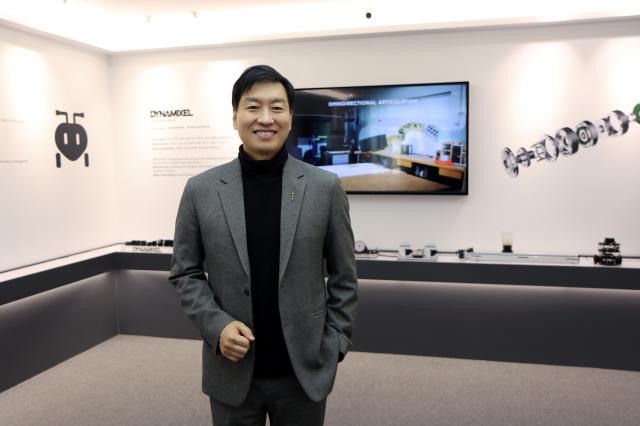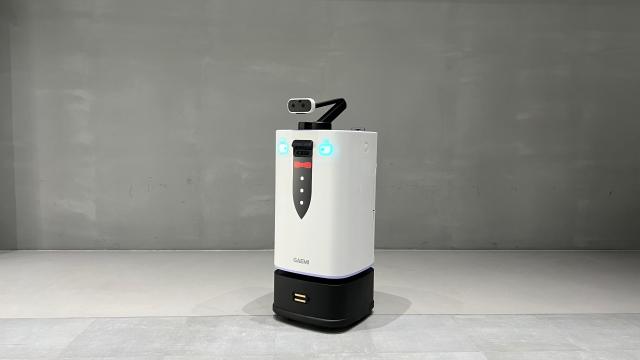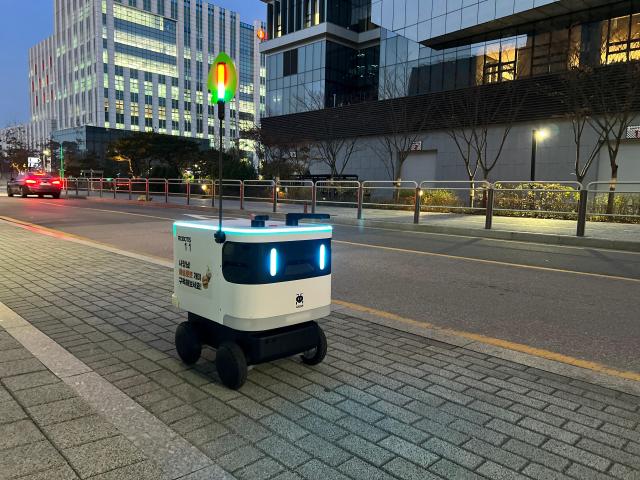
SEOUL, April 08 (AJU PRESS) - Inside the headquarters of South Korean robotics technology company ROBOTIS, located in southwestern Seoul, a scene reminiscent of science fiction unfolds. Tower-shaped service robots silently roam the campus, delivering drinks and snacks to employees. On the main wall in the lobby, the company motto reads: "Freedom from Work."
The autonomous service robots seen here are called "Gaemi" (meaning "ant" in Korean). Both the indoor and outdoor versions can carry up to 30 kilograms (66 pounds) and operate for eight hours per full charge. Currently, Gaemi robots are actively delivering food and drinks from restaurants and cafes to customers' doorsteps in the area surrounding ROBOTIS' headquarters.
"We believe service robots should be designed to lift the workload off human workers," ROBOTIS CEO Kim Byoung-soo told Aju Press on April 4. "Our ultimate goal is to create an environment where humans no longer need to engage in physical work. Robots can be deployed to workplaces that are dirty and dangerous."
Founded in 1999, ROBOTIS made its first steps in the robotics research sector and accelerated the development and commercialization of robot technologies, including actuator modules, which convert electric signals into physical motion, as well as autonomous technologies and various robot platforms, for various industries including service robots, automated machinery, and other sectors involving ROBOTIS' actuator parts.
"We think our strength lies in our know-how of developing and manufacturing actuators. Many companies manufacture autonomous robots, and we try to differentiate our products using our actuator technologies," Kim said.
Current service robots, often resembling small cabinets on wheels, typically communicate remotely with elevators to move independently between floors. However, they cannot operate older elevators that lack a communication module.

The indoor-type Gaemi robot stands out with its actuator-powered manipulator, acting like the hand of a bellhop. Using artificial intelligence-based vision technology, Gaemi recognizes elevator buttons via cameras and presses the button for its destination floor. It navigates by identifying room numbers and knocks on doors for occupants to retrieve their deliveries.
While some other companies produce service robots with manipulators, these arms often cost over 20 million won ($14,764). This is because they're designed for industrial uses, with complex joints and the ability to lift objects exceeding 100 kilograms.
Gaemi's robot arm is tailored for its specific tasks, such as pressing elevator buttons or knocking. This makes it much more affordable. "Gaemi's arm costs about five percent of the price of a small-sized industrial robot arm," Kim explained. He emphasized that a robot arm is essential for maximizing a delivery robot's effectiveness but that robot service operators shouldn't have to overpay for features beyond what the robot actually needs.
ROBOTIS currently supplies actuators to clients both domestically and abroad, including companies and organizations in the global automotive, defense, and entertainment sectors. The South Korean robotics technology company aims to expand in the global robot parts market with new "Dynamixel" actuator models.
According to global market analyst firm Markets and Markets, the global service robot market is expected to grow at an average annual growth rate of 15.4 percent, reaching $84.8 billion by 2028 from $41.5 billion in 2023. The global actuator market, crucial for robots and other autonomous machines, is projected to reach $52.9 billion by 2028, demonstrating an average annual growth rate of 15.4 percent.
While ROBOTIS currently focuses on developing wheeled service robots, the company has a history of leadership in humanoid robots, where delicate actuators are essential.

Kim is confident that service robots like Gaemi will see widespread adoption in South Korea within five years, thanks to the nation's advanced mobile internet infrastructure and rapid AI development. "Until recently, robots had to be stationary due to difficulties in object recognition and making safety-critical decisions. Now, thanks to deep learning technology and the development of AI, robots can safely and freely mingle with humans," Kim said.
Kim believes that the full commercialization of service robots will come faster than fully autonomous vehicles. "It is because autonomous systems controlling a 100-kilogram service robot will find it easier than controlling a vehicle that weighs more than 1.5 tons," Kim said, adding that in the case of accidents, service robots are unlikely to cause fatal accidents compared to vehicles traveling at fast speeds.
When autonomous technologies fully become part of our lives in the future, Kim stressed that it will be time for humans to think about broader social issues. "Discussions regarding social issues sparked by service robots at workplaces must be continued alongside the development of related technologies to create a world where people and autonomous machines could co-exist. I think humans can work things out," Kim said.
Copyright ⓒ Aju Press All rights reserved.




